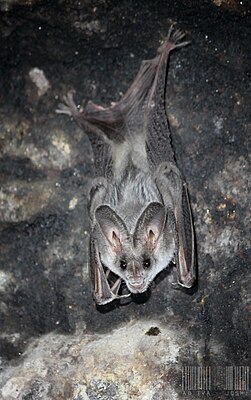Indian fake vampire
| Indian fake vampire | ||||||||||||
|---|---|---|---|---|---|---|---|---|---|---|---|---|

Indian false vampire ( Megaderma lyra ) |
||||||||||||
| Systematics | ||||||||||||
|
||||||||||||
| Scientific name | ||||||||||||
| Megaderma lyra | ||||||||||||
| ( Geoffroy , 1810) |
The Indian false vampire ( Megaderma lyra ) is a species of horseshoe bat bat . It occurs in Asia. The Indian false vampire is one of the carnivorous bats. The Indian false vampire is not related to the genus of the vampire bats , despite some similarities in the way of life.
Appearance
The Indian false vampire reaches a head-trunk length of 6.5 to 9.5 centimeters. It weighs between 40 and 60 grams.
The fur of the Indian false vampire is gray-brown on the top and whitish-gray on the underside. Like all large-leaf noses , the Indian false vampire is characterized by its large ears, large nasal blade and the absence of a tail. The eyes are very large in relation to the head.
distribution
The Indian false vampire is found in South Asia and Southeast Asia. Countries with a deposit include Pakistan, India, Sri Lanka, Myanmar, southern China, Malaysia, and the Philippines. Its habitat are moist forests.
Way of life
The Indian false vampire eats small bats and birds, lizards and frogs, fish, mice and rats, and large insects. The hunt begins at dusk. During the day, Indian false vampires rest in caves, abandoned mines and under roofs. They change their resting places very often. Other species of bats avoid the resting places of the Indian false vampire.
Hunting Indian false vampires search the edges of waterholes, rocks and walls for prey. The relatively wide, short wings prevent them from flying very quickly, but they are able to stay in the air in one place. As soon as they have caught a prey, they return with it to certain waiting places in order to consume the animal there.
Indian false vampires are active all year round and do not hibernate. However, it is very likely that they will undertake seasonal migrations.
supporting documents
literature
- Ronald M. Nowak: Walker's Mammals of the World . Johns Hopkins University Press, 1999, ISBN 0-8018-5789-9
- Tej Kumar Shrestha: Wildlife of Nepal - A Study of Renewable Resources of Nepal Himalayas. Tribhuvan University, Kathmandu 2003, ISBN 99933-59-02-5
Single receipts
Web links
- Megaderma lyra inthe IUCN 2013 Red List of Threatened Species . Submitted by: Csorba, G., Bates, P., Molur, S. & Srinivasulu, C., 2008. Retrieved December 28, 2013.


